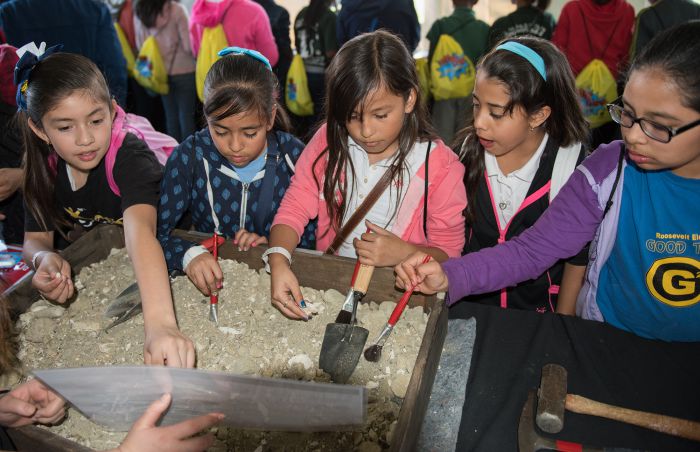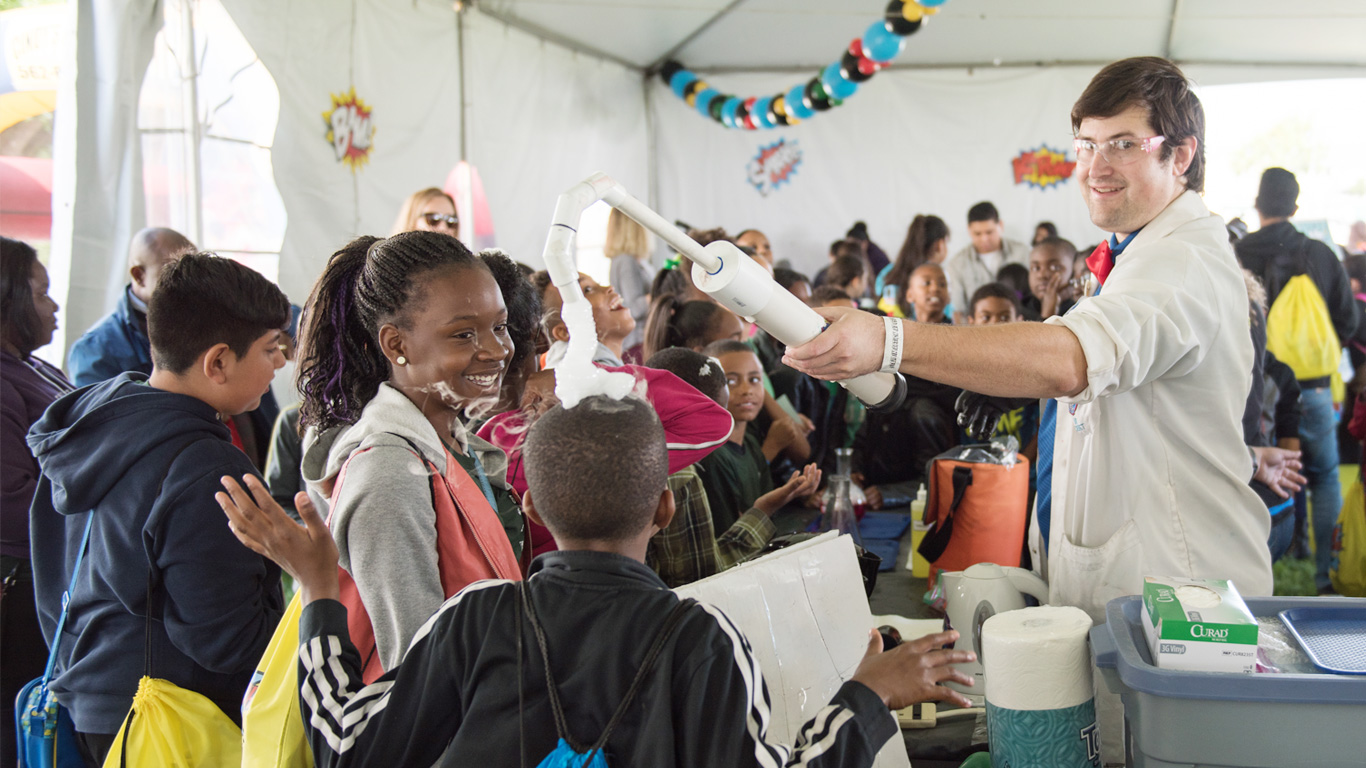
Was it a steady flow of soft serve ice cream, or just your everyday swirl of carbon dioxide gas bubbles being streamed onto a boy’s head?
Justin Time-and-Space, a Mad Science Group, Inc. employee with a questionable last name, said “both would be fun,” then corrected the boy’s ice cream quip in humorous yet scientific detail.
The concoction was being served up during California State University, Dominguez Hills (CSUDH) 2nd annual STEM in Action: Kid’s Conference on March 11. The conference invited nearly 700 inner-city elementary, and middle school students from the Los Angeles area to explore the lighter side of science in fun and creative ways.
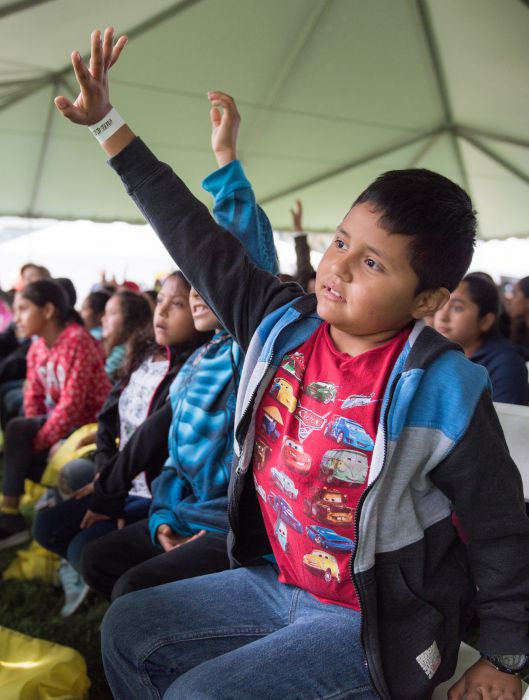
“It sounds a bit complicated, but it’s really not. Inside the tube is hot water, soap and dry ice, and then comes salt water that will start to sublimate the carbon dioxide gas, creating carbon dioxide within a soap bubble,” said Time-and Space, who was joined by other Mad Science employees to work with kids in other booths at the conference. “Because carbon dioxide is heavier than air, these bubbles tend to maintain their shape a lot better. So you get those nice long snake streams.”
STEM in Action and its exciting workshops, competitions, and activities, was designed to fuel the young students’ excitement for science, technology, engineering, and mathematics (STEM) disciplines while providing future educators in CSUDH teacher education programs with the opportunity to help facilitate or observe fun and interactive lessons that engage students. Some of the other activities at the conference included a virtual reality station, engineering challenges, soda bottle rocket launchers, and building mousetrap cars.
The conference was coordinated by CSUDH’s STEM Institute for Innovation and Improvement (CSI3), a component of the Center for Innovation in STEM Education (CISE) at CSUDH, which is dedicated to addressing the shortage of STEM teachers in high-need schools in and around Los Angeles, and across the state.
In addition, through the grants and projects that are managed by the CSI³ and CISE teams, CSUDH has been able to offer K-16 students opportunities to engage them in exciting STEM activities, such as the STEM in Action: A Kids Conference, STEM in Education Conference, Pi Day, STEM Lab Schools, field trips with our STEM faculty, research opportunities with our STEM faculty, and much more.
Substantial grants have also played a role in such programs as the Robert Noyce Scholars Program, which if funded by the National Science Foundation; the Math and Science Teacher Initiative supported by the grant from the CSU Office of the Chancellor; and the Pathways Academy, which is also funded by the DOE. Department of Education (Pathways Academy funded by a grant from USDOE), and other sources.
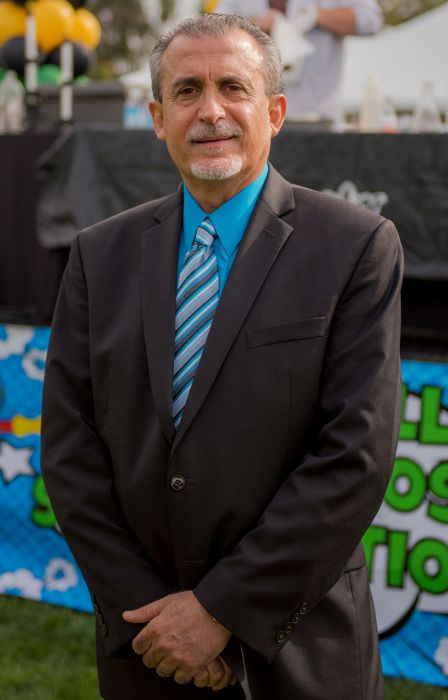
Kamal Hamdan, CISE director, said that due to overwhelming interest, this year’s conference was been split into two events, with the March 11 event geared toward K-8 students, and a second STEM in Action conferenced planned for fall for high school students from the region. While both events offer fun, hands-on activities, the teenagers will also benefit from more college-focused science, inspirational speakers, the opportunity to meet with college advisers, and information about financial aid.
“Our first year in 2015 greatly exceeded our expectations. It really let the kids see STEM come alive,” said Hamdan. “This year the expectations were much higher. Our team was up the past several nights very late preparing each lesson, which were developed based on the new generation science standards, Common Core standards and 21st Century skills.”
CSUDH is one of the state’s leading universities in preparing highly qualified educators. Between 2006 and 2012, the university produced more math and science teacher combined than any other campus in the 23-campus California State University (CSU) system, and has been one of the top three ever since. The university’s students and teacher candidates benefit from variety of alternative teacher pathways. They include the Transition to Teaching (TTT) programs, the STEM Teachers in Advanced Residency (STAR) program, and the Secondary Special Education Teacher Interventionist (SSETI), which are all funded by major grants from the U.S. Department of Education (DOE).
This year STEM in Action also celebrated Pi Day (March 14) with pi-themed activities, such as a memorization contest, a pi(e) eating contest, and an opportunity for students to derive the origin of pi.
“One of the real fun things the kids will be doing is a pi-ñata, you know, like a piñata. They’re going to try to estimate, based on each hit with a stick, how many pieces of candy will fall out. Most likely it will be 3.14 pieces of candy,” Hamdan joked.

Along with Mad Science employees, CSUDH students and teenagers from local high schools operated the booths at the conference. They included Hector Hernandez, a sophomore from STEAM Legacy High School in South Gate, who at 15 is already enrolled in pre-calculus. He was working in the “Deriving Pi” booth.
“Today we’re going to introduce the kids to pi by having them measure the circumference of a certain item, and then the diameter, since pi is equal to circumference divided by the diameter,” explained Hernandez, who loves math but wants to study art in college to become a cartoonist. “The kids will then divide the numbers in a calculator, and find the number to be really close to pi, which is 3.14.
“After the students go through my booth my hope is that they understand more about pi, and if they do, they will be able to apply it in the future,” Hernandez added. “Pi will be useful for them in such subjects as geometry, pre-calculus, and even algebra.”
The United States currently confers the lowest rates of STEM-related bachelor’s degrees worldwide, with STEM accounting for 17 percent of all degrees awarded in 2002 compared to the international average of 26 percent, according to a report presented to the U.S. Congress by Jeffrey J. Kuenzi in 2008.
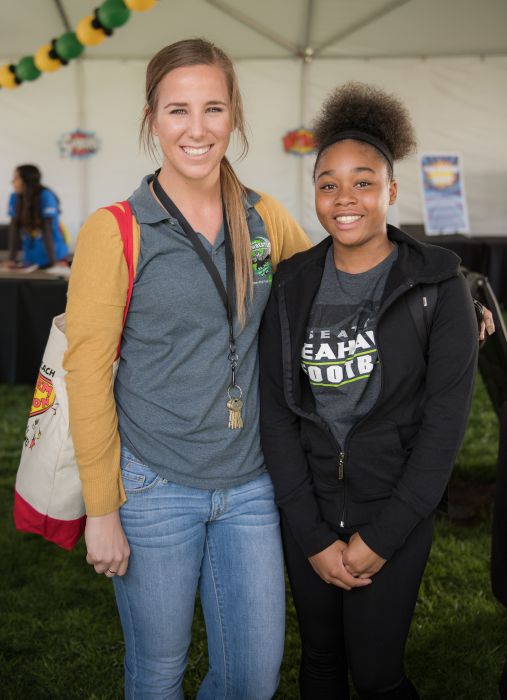
Amanda Lobello (’13, B.S., mathematics education), Bachelor of Science , who completed the TTT program at CSUDH and now teaches 7th and 8th grade mathematics at Ánimo Phillis Wheatley Charter Middle School in Los Angeles, is doing her part to help improve those percentages by introducing STEM to more underserved students. She develops fun-based STEM experiments and activities in her classroom similar to those her students enjoyed at STEM in Action.
“In my classroom I try to build my students interest in math with coloring projects, candy wrappers and candy activities, and other projects so they can see that there is math involved in real-world applications and situations, as well as art–there is a lot of math in art,” she said. “One of the things that I think the students are taking away from today’s event is that math is everywhere. It’s important to get them involved and get them in the mindset that it’s not difficult.”
Alaia Barrington-Grant, one of Lobello’s 7th grade students, reluctantly admitted to being one of the best students in her math class, and that she was going to get an “A” this year, which Lobello confirmed.
“I’m a good math student. One of the things I like the most about math is the way Ms. Lobello teaches it,” said Barrington-Grant, who was fascinated by the “animals” she created with a 3D printer at the conference. She moves us along pretty quickly, so we learn pretty fast. We use our hands a lot in class, but we use our brains a lot more.”
